Middleton W.M. (ed.) Reference Data for Engineers: Radio, Electronics, Computer and Communications
Подождите немного. Документ загружается.

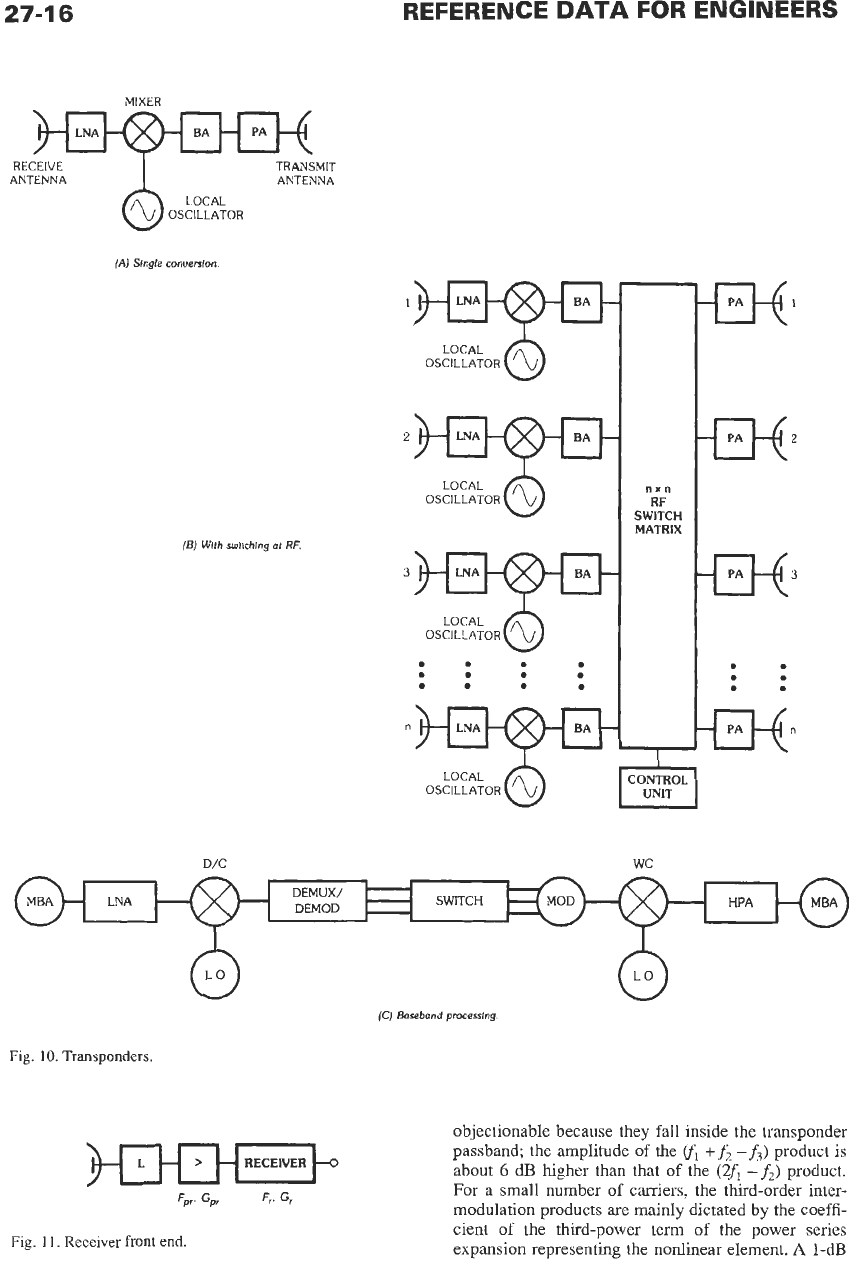
27-1
6
REFERENCE
DATA
FOR ENGINEERS
MIXER
RECEIVE TRANSMIT
ANTENNA
ANTENNA
LOCAL
OSCILLATOR
(A)
Slngle
conuerston
1
1
fBJ
WlLh swltchlng
ai
RF.
LOCAL
OSCILLATOR
2
nxn
RF
SWITCH
MATRIX
3
i"
n
n
D/C
wc
SWITCH
Fig.
10.
Transponders.
Fig.
11.
Receiver
front
end.
(C)
Baseband processing.
objectionable because they fall inside
the
transponder
passband the amplitude of the
+fi
-f3)
product is
about
6
dB higher than that
of
the
(2f1
-fi)
product.
For a small number of carriers, the third-order inter-
modulation products are mainly dictated by the coeffi-
cient
of
the third-power term of the power series
expansion representing the nonlinear element.
A
1-dB
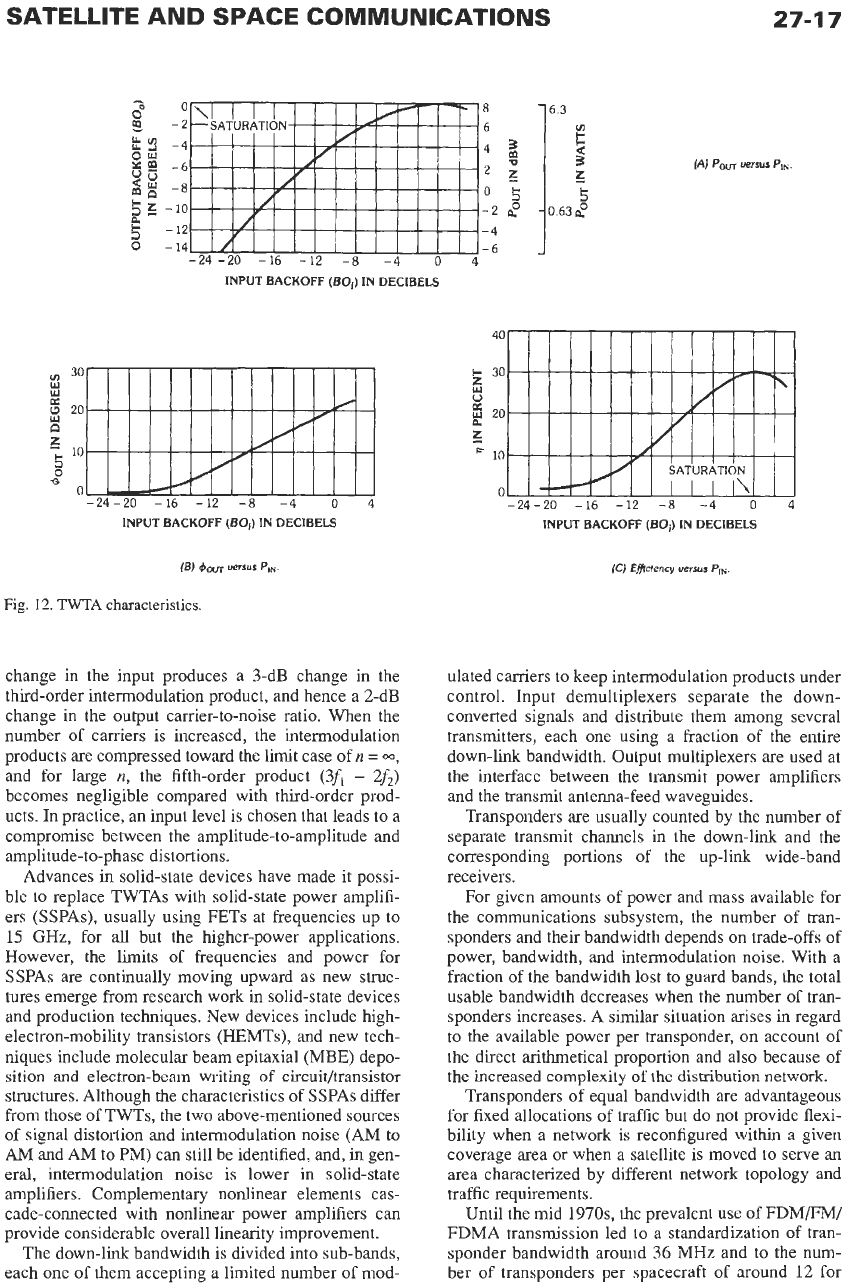
SATELLITE AND SPACE COMMUNICATIONS
-
8
g
-2
6
ow
5E
-6
52
-10
-2
3
L
2
-14
-6
-
00
::y
-4 43
3
05
gg
u
-a
2E
-
12
-4
27-1
7
-63
E
s
E
c
-0633
v)
30
Y
3
20
n
E
10
5
n:
a
0
-24-20
-16
-12
-8
-4 0
4
INPUT
BACKOFF
(BOi)
IN
DECIBELS
(B)
+m
versus
PIN
Fig.
12.
TWTA
characteristics.
change in the input produces a 3-dB change in the
third-order intermodulation product, and hence a 2-dB
change in the output carrier-to-noise ratio. When the
number of carriers is increased, the intermodulation
products are compressed toward the limit case
of
n
=
03,
and for large
n,
the fifth-order product (3fi
-
2f2)
becomes negligible compared with third-order prod-
ucts. In practice, an input level is chosen that leads to a
compromise between the amplitude-to-amplitude and
amplitude-to-phase distortions.
Advances in solid-state devices have made it possi-
ble to replace TWTAs with solid-state power amplifi-
ers (SSPAs), usually using FETs at frequencies up to
15
GHz, for
all
but the higher-power applications.
However, the limits of frequencies and power for
SSPAs are continually moving upward as new struc-
tures emerge from research work in solid-state devices
and production techniques. New devices include high-
electron-mobility transistors (HEMTs), and new tech-
niques include molecular beam epitaxial (MBE) depo-
sition and electron-beam writing
of
circuit/transistor
structures. Although the characteristics of SSPAs differ
from those of
TWTs,
the two above-mentioned sources
of signal distortion and intermodulation noise (AM to
AM and AM to PM) can still be identified, and, in gen-
eral, intermodulation noise is lower in solid-state
amplifiers. Complementary nonlinear elements cas-
cade-connected with nonlinear power amplifiers can
provide considerable overall linearity improvement.
The down-link bandwidth
is
divided into sub-bands,
each one of them accepting a limited number of mod-
(A)
POW
versus
Pi,.
INPUT
BACKOFF
(SOi)
IN
DECIBELS
(C)
Eficlency
versus
PfN.
ulated carriers to keep intermodulation products under
control. Input demultiplexers separate the down-
converted signals and distribute them among several
transmitters, each one using a fraction of the entire
down-link bandwidth. Output multiplexers
are
used at
the interface between the transmit power amplifiers
and the transmit antenna-feed waveguides.
Transponders are usually counted by the number of
separate transmit channels in the down-link and the
corresponding portions of the up-link wide-band
receivers.
For given amounts of power and mass available for
the communications subsystem, the number of tran-
sponders and their bandwidth depends on trade-offs of
power, bandwidth, and intermodulation noise. With a
fraction of the bandwidth lost to guard bands, the total
usable bandwidth decreases when the number of tran-
sponders increases. A similar situation arises in regard
to the available power per transponder, on account of
the direct arithmetical proportion and also because of
the
increased complexity
of
the
distribution network.
Transponders
of
equal bandwidth are advantageous
for fixed allocations of traffic but do not provide flexi-
bility when a network is reconfigured within a given
coverage area or when a satellite is moved to serve an
area characterized by different network topology and
traffic requirements.
Until the mid
1970s,
the prevalent
use
of
FDM/FM/
FDMA transmission led to a standardization of tran-
sponder bandwidth around
36
MHz and to the num-
ber of transponders per spacecraft of around 12 for
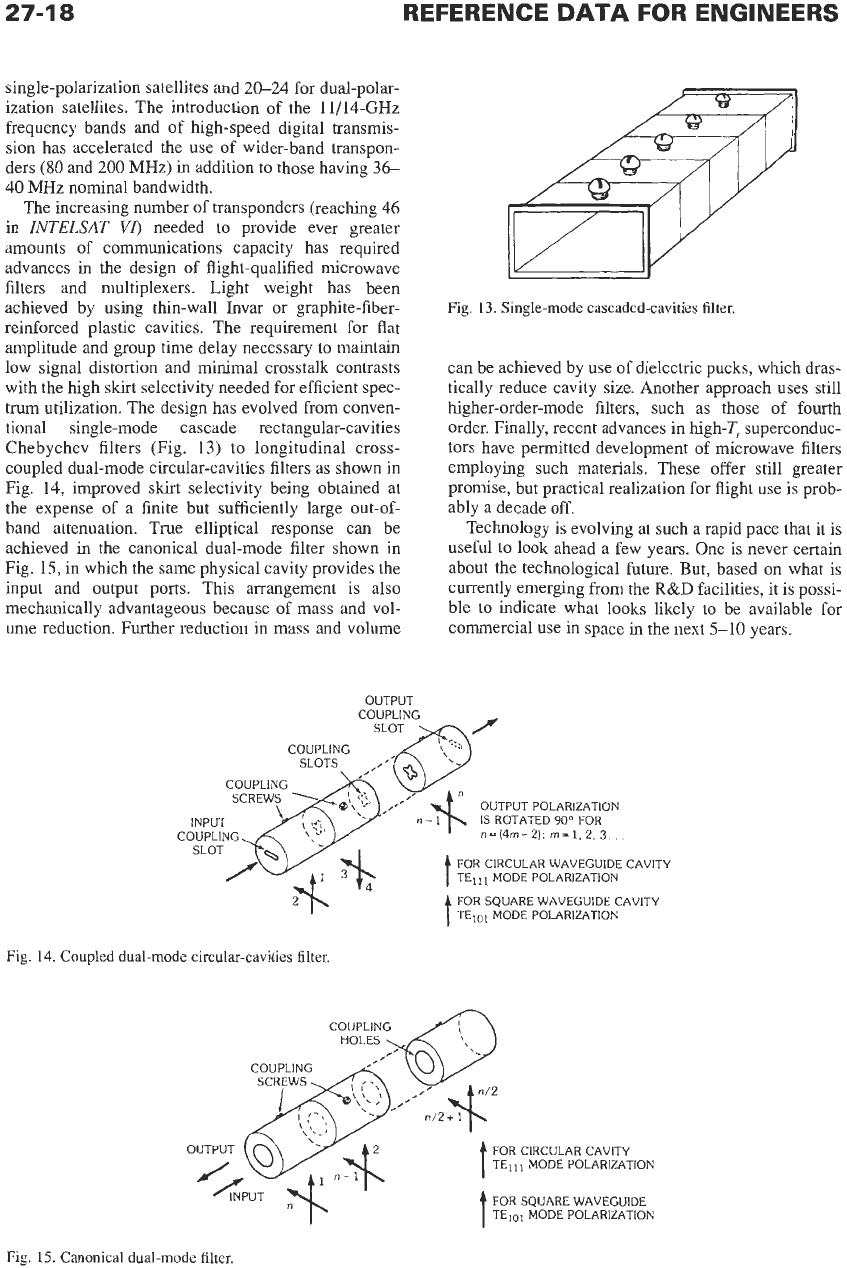
27-1
8
REFERENCE
DATA
FOR ENGINEERS
single-polarization satellites and 20-24 for dual-polar-
ization satellites. The introduction of the 11/14-GHz
frequency bands and of high-speed digital transmis-
sion has accelerated the use
of
wider-band transpon-
ders
(80
and
200
MHz) in addition to those having
36-
40 MHz nominal bandwidth.
The increasing number of transponders (reaching 46
in
INTELSAT
Vo
needed to provide ever greater
amounts of communications capacity has required
advances in the design of flight-qualified microwave
filters and multiplexers. Light weight has been
achieved by using thin-wall Invar or graphite-fiber-
reinforced plastic cavities. The requirement for flat
amplitude and group time delay necessary to maintain
low signal distortion and minimal crosstalk contrasts
with the high
skirt
selectivity needed for efficient spec-
trum utilization. The design has evolved from conven-
tional single-mode cascade rectangular-cavities
Chebychev filters (Fig.
13)
to longitudinal cross-
coupled dual-mode circular-cavities filters as shown in
Fig. 14, improved
skirt
selectivity being obtained at
the expense of a finite but sufficiently large out-of-
band attenuation. True elliptical response can be
achieved in the canonical dual-mode filter shown in
Fig.
15,
in which the same physical cavity provides the
input and output ports. This arrangement is also
mechanically advantageous because
of
mass and vol-
ume reduction. Further reduction in mass and volume
Fig.
14.
Coupled dual
Fig.
13.
Single-mode cascaded-cavities filter.
can be achieved by use of dielectric pucks, which dras-
tically reduce cavity size. Another approach uses still
higher-order-mode filters, such as those
of
fourth
order. Finally, recent advances in high-T, superconduc-
tors have permitted development of microwave filters
employing such materials. These offer still greater
promise, but practical realization for flight use is prob-
ably a decade
off.
Technology is evolving at such a rapid pace that it is
useful to look ahead a few years. One is never certain
about the technological future. But, based on what is
currently emerging from the
R&D
facilities, it is possi-
ble
to
indicate what looks likely to be available for
commercial use in space in the next 5-10 years.
OUTPUT
COUPLING
SCREWS
INPUT
COUPLING
SLOT
FOR CIRCULAR WAVEGUIDE CAVITY
TElll MODE POLARIZATION
FOR SQUARE WAVEGUIDE CAVITY
MODE POLARIZATION
-mode circular-cavities
filter.
C
0
HOLES UP
L
I
N
G
@
'.
COUPLING
L'
,
FOR CIRCULAR CAVITY
TElli MODE POLARIZATION
FOR SQUARE WAVEGUIDE
TElol
MODE POLARIZATION
t
t
Fig.
15.
Canonical dud-mode filter.
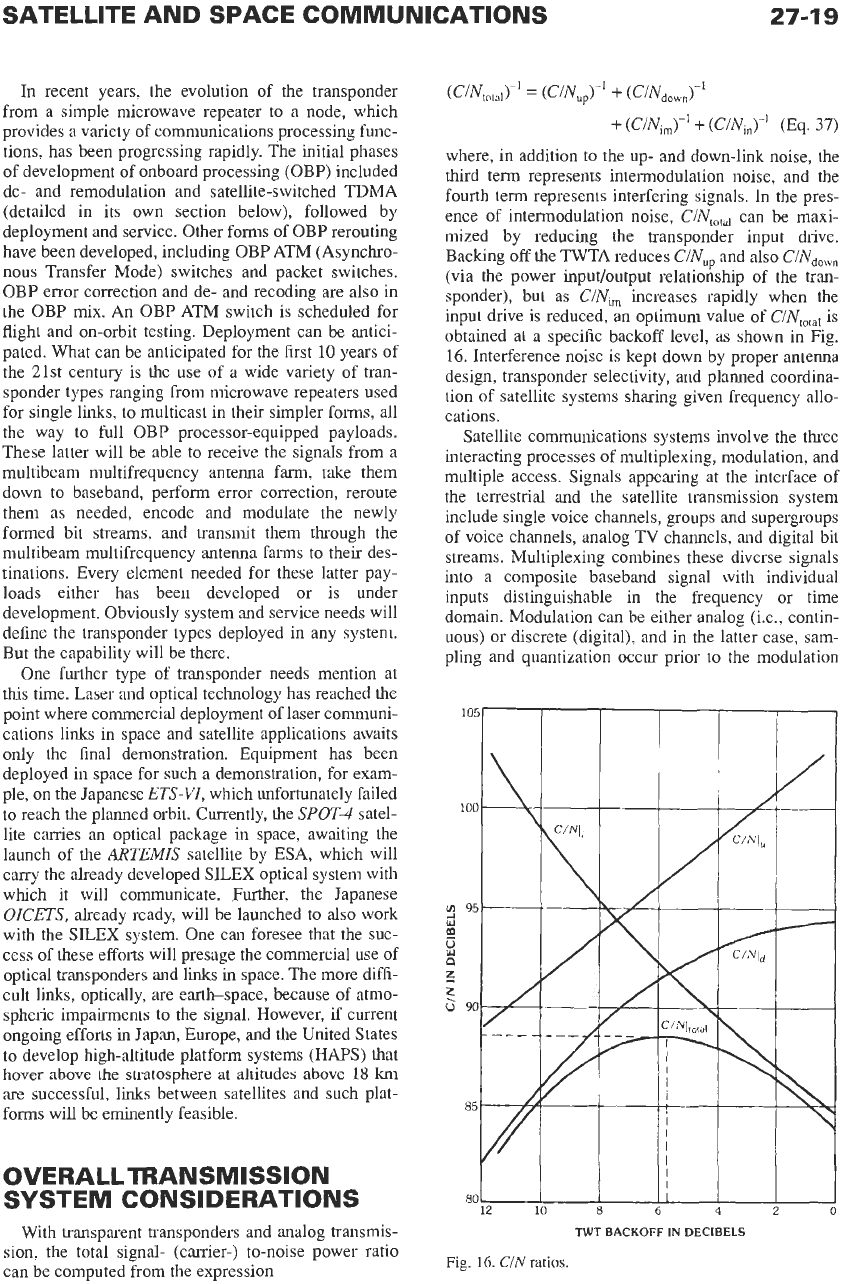
SATELLITE AND SPACE COMMUNICATIONS
27-1
9
105
In
recent years, the evolution of the transponder
from a simple microwave repeater to a node, which
provides a variety of communications processing func-
tions, has been progressing rapidly. The initial phases
of development
of
onboard processing (OBP) included
de- and remodulation and satellite-switched TDMA
(detailed in its own section below), followed by
deployment and service. Other forms of
OBP
rerouting
have been developed, including
OBP
ATM (Asynchro-
nous
Transfer Mode) switches and packet switches.
OBP error correction and de- and recoding are also in
the OBP mix.
An
OBP ATM switch is scheduled for
flight and on-orbit testing. Deployment can be antici-
pated. What can be anticipated for the first
10
years of
the 21st century is the use of a wide variety of tran-
sponder types ranging from microwave repeaters used
for single links,
to
multicast in their simpler forms, all
the way
to
full OBP processor-equipped payloads.
These latter will be able
to
receive the signals from a
multibeam multifrequency antenna farm, take them
down to baseband, perform error correction, reroute
them as needed, encode and modulate the newly
formed bit streams, and transmit them through the
multibeam multifrequency antenna farms to their des-
tinations. Every element needed for these latter pay-
loads either has been developed or is under
development. Obviously system and service needs will
define the transponder types deployed in any system.
But the capability will be there.
One further type of transponder needs mention at
this
time. Laser and optical technology has reached the
point where commercial deployment of laser communi-
cations links in space and satellite applications awaits
only the final demonstration. Equipment has been
deployed in space for such a demonstration, for exam-
ple,
on
the Japanese
ETS-VI,
which unfortunately failed
to
reach the planned orbit. Currently, the
SPOT-4
satel-
lite carries an optical package
in
space, awaiting the
launch of the
ARTEMIS
satellite by ESA, which will
carry the already developed
SILEX
optical system with
which it will communicate. Further, the Japanese
OICETS,
already ready, will be launched to also work
with the SILEX system. One can foresee that the suc-
cess of these efforts will presage the commercial use of
optical transponders and links in space. The more diffi-
cult links, optically,
are
earth-space, because of atmo-
spheric impairments to the signal. However,
if
current
ongoing efforts
in
Japan, Europe, and the United States
to develop high-altitude platform systems
(HAPS)
that
hover above the stratosphere
at
altitudes
above
18
km
are successful, links between satellites and such plat-
forms will be eminently feasible.
,
OVERALL TRANSMISSION
SYSTEM CONSIDERATIONS
With transparent transponders and analog transmis-
sion, the total signal- (carrier-) to-noise power ratio
can be computed from the expression
where, in addition to the up- and down-link noise, the
third term represents intermodulation noise, and the
fourth term represents interfering signals.
In
the pres-
ence of intermodulation noise,
CIN,,,
can be maxi-
mized by reducing the transponder input drive.
Backing off the TWTA reduces
C/Nup
and also
C/Ndown
(via the power input/output relationship of the tran-
sponder), but as
C/Nim
increases rapidly when the
input drive is reduced, an optimum value of
C/Ntota,
is
obtained at a specific backoff level, as shown in Fig.
16.
Interference noise is kept down by proper antenna
design, transponder selectivity, and planned coordina-
tion of satellite systems sharing given frequency allo-
cations.
Satellite communications systems involve the three
interacting processes of multiplexing, modulation, and
multiple access. Signals appearing at the interface of
the terrestrial and the satellite transmission system
include single voice channels, groups and supergroups
of voice channels, analog
TV
channels, and digital bit
streams. Multiplexing combines these diverse signals
into a composite baseband signal with individual
inputs distinguishable in the frequency or time
domain. Modulation can be either analog (Le., contin-
uous)
or discrete (digital), and in the latter case, sam-
pling and quantization occur prior
to
the modulation
TWT
BACKOFF
IN
DECIBELS
Fig.
16.
CIN
ratios.

27-20
process itself. Amplitude modulation has been little
BPSK and QPSK modulations have been widely used.
Multiple access is a unique feature of satellite com-
a
satellite, transponders can be shared by several earth-
station pairs. The number
of
possible connections is
then
used; analog phase or frequency modulation or digital
Mode
f
Separatron
of
the Accesses
by:
munications: When
rn
earth stations are “visible” from
FDMA
FILTERING
t
f
Iz
=
m(m
-
1)/2
(Eq.
38)
This “n-port” network feature is very attractive in
comparison with the inflexibility
of
the “2-port’’ con-
figuration encountered in most earth-based communi-
cations systems.
Individual accesses are kept separate in a physical
domain such as frequency, time, or space (Le., by sepa-
rate antenna beams) or by encoding. The accesses can
be preassigned in a static mode or dynamically
assigned
on
demand. Fig.
17
illustrates three principal
modes of multiple access, and Table
2
outlines their
major features.
Because modulation and multiple access are interac-
tive processes, the choice of a specific method
of
mul-
tiple access depends
on
the best utilization of the
available power and bandwidth. The number of
accesses should be made as large as possible while sig-
nal impairments caused by imperfections of the trans-
mission channel are kept within specified margins. The
f
A
Fig.
17.
Multiple-access schemes.
overall system design is also influenced by the charac-
teristics of the terrestrial interface. Analog voice and
video transmission systems predominant in the mid-
1960s
in terrestrial systems led to the adoption of
TABLE
2.
FEATURES
OF
MULTIPLE-ACCESS SCHEMES
Type Characteristics Advantages Disadvantages
FDMA Constant envelope signals Easy interfacing with terrestrial
Angle modulation (analog or
Separation by filtering
analog facilities
digital) No need for synchronization
Simple earth-station equipment
TDMA Bursts from and to different Fairly easy interfacing with
terrestrial digital facilities
Power amplifiers operate near
stations do not overlap
time saturation at higher efficiency
Only one burst present at a given
Separation by time gating
Highest communications capacity
No
need for power control and
Transmission plan is flexible
coordination
Spread spectrum provides
protection against jamming
Intermodulation noise in nonlin-
ear amplifiers reduces commu-
nications capacity
Backoff required
Up-link power coordination is
Transmission plan is difficult to
required
reconfigure
Need for coordinated synchroni-
More complex earth-station
A/D
and D/A conversion required
zation
equipment
CDMA Constant envelope signals Synchronization is required
Communications capacity is
Signal quality worsens when
Power coordination is needed
Each access takes the whole
Separation by correlation
transponder bandwidth somewhat limited
number of accesses increases
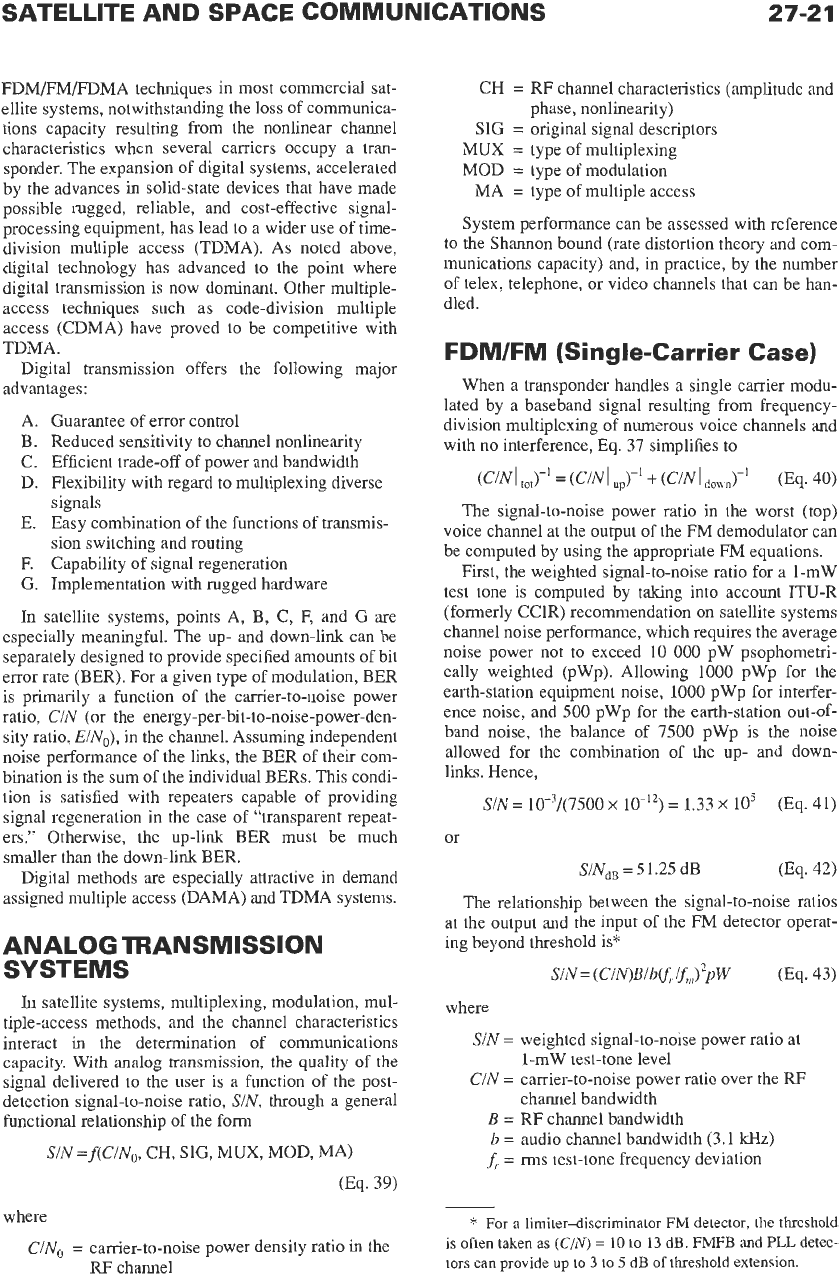
SATELLITE AND SPACE COMMUNICATIONS
27-21
FDM/FM/FDMA techniques in most commercial sat-
ellite systems, notwithstanding the loss of communica-
tions capacity resulting from the nonlinear channel
characteristics when several carriers occupy a tran-
sponder. The expansion of digital systems, accelerated
by the advances in solid-state devices that have made
possible rugged, reliable, and cost-effective signal-
processing equipment, has lead to a wider use
of
time-
division multiple access (TDMA). As noted above,
digital technology has advanced to the point where
digital transmission is now dominant. Other multiple-
access techniques such as code-division multiple
access (CDMA) have proved
to
be competitive with
TDMA.
Digital transmission offers the following major
advantages:
A. Guarantee of error control
B. Reduced sensitivity to channel nonlinearity
C. Efficient trade-off of power and bandwidth
D. Flexibility with regard to multiplexing diverse
signals
E. Easy combination of the functions of transmis-
sion switching and routing
F. Capability
of
signal regeneration
G.
Implementation with rugged hardware
In satellite systems, points A, B, C,
F,
and G are
especially meaningful. The up- and down-link can be
separately designed
to
provide specified amounts of bit
error rate (BER). For a given type of modulation, BER
is primarily a function
of
the carrier-to-noise power
ratio,
CIN
(or the
energy-per-bit-to-noise-power-den-
sity ratio,
EINo),
in the channel. Assuming independent
noise performance of the links, the BER of their com-
bination is the sum of the individual BERs. This condi-
tion is satisfied with repeaters capable of providing
signal regeneration in the case of “transparent repeat-
ers.” Otherwise, the up-link BER must be
much
smaller than the down-link BER.
Digital methods are especially attractive in demand
assigned multiple access (DAMA) and TDMA systems.
ANALOG TRANSMISSION
SYSTEMS
In satellite systems, multiplexing, modulation, mul-
tiple-access methods, and the channel characteristics
interact in the determination of communications
capacity. With
analog
transmission, the quality
of
the
signal delivered to the user is a function of the post-
detection signal-to-noise ratio,
SIN,
through a general
functional relationship of the form
SIN
=
f(CINo,
CH, SIG, MUX, MOD, MA)
(Eq. 39)
where
CIN,,
=
carrier-to-noise power density ratio in the
RF channel
CH
=
RF channel characteristics (amplitude and
phase, nonlinearity)
SIG
=
original signal descriptors
MUX
=
type of multiplexing
MOD
=
type of modulation
System performance can be assessed with reference
to the Shannon bound (rate distortion theory and com-
munications capacity) and, in practice, by the number
of telex, telephone, or video channels that can be han-
dled.
MA
=
type of multiple access
FDM/FM
(Single-Carrier Case)
When a transponder handles a single carrier modu-
lated by a baseband signal resulting from frequency-
division multiplexing of numerous voice channels and
with
no
interference, Eq. 37 simplifies to
(CIN
I
tot)-1
=
(CIN
I
up)-1
+
(CIN
I
down)-’
(Eq.
40)
The signal-to-noise power ratio
in
the worst (top)
voice channel at the output of the
FM
demodulator can
be computed by using the appropriate
FM
equations.
First, the weighted signal-to-noise ratio for a
1-mW
test tone is computed by taking into account ITU-R
(formerly CCIR) recommendation
on
satellite systems
channel noise performance, which requires the average
noise power
not
to exceed 10
000
pW psophometri-
cally weighted (pWp). Allowing
1000
pWp for the
earth-station equipment noise,
1000
pWp for interfer-
ence noise, and
500
pWp for the earth-station out-of-
band noise, the balance of 7500 pWp is the noise
allowed for the combination of the up- and down-
links. Hence,
SIN
=
10-3/(7500
x
lo-’’)
=
1.33
x
10’
(Eq.
41)
or
SINdB
=
5
1.25
dB
0%.
42)
The relationship between the signal-to-noise ratios
at the output and the input of the FM detector operat-
ing beyond threshold is*
SIN=
(ClN)Blb(f,
if,)$W
(Eq. 43)
where
SIN
=
weighted signal-to-noise power ratio at
CIN
=
carrier-to-noise power ratio over the
RF
1-mW
test-tone level
channel bandwidth
B
=
RF channel bandwidth
b
=
audio channel bandwidth (3.1
kHz)
f,
=
rms test-tone frequency deviation
*
For
a
limiter-discriminator
F’M
detector,
the
threshold
is
often
taken
as
(C/N
=
10
to
13 dB.
FMFB
and
PLL
detec-
tors
can
provide
up
to 3
to
5
dB
of
threshold extension.
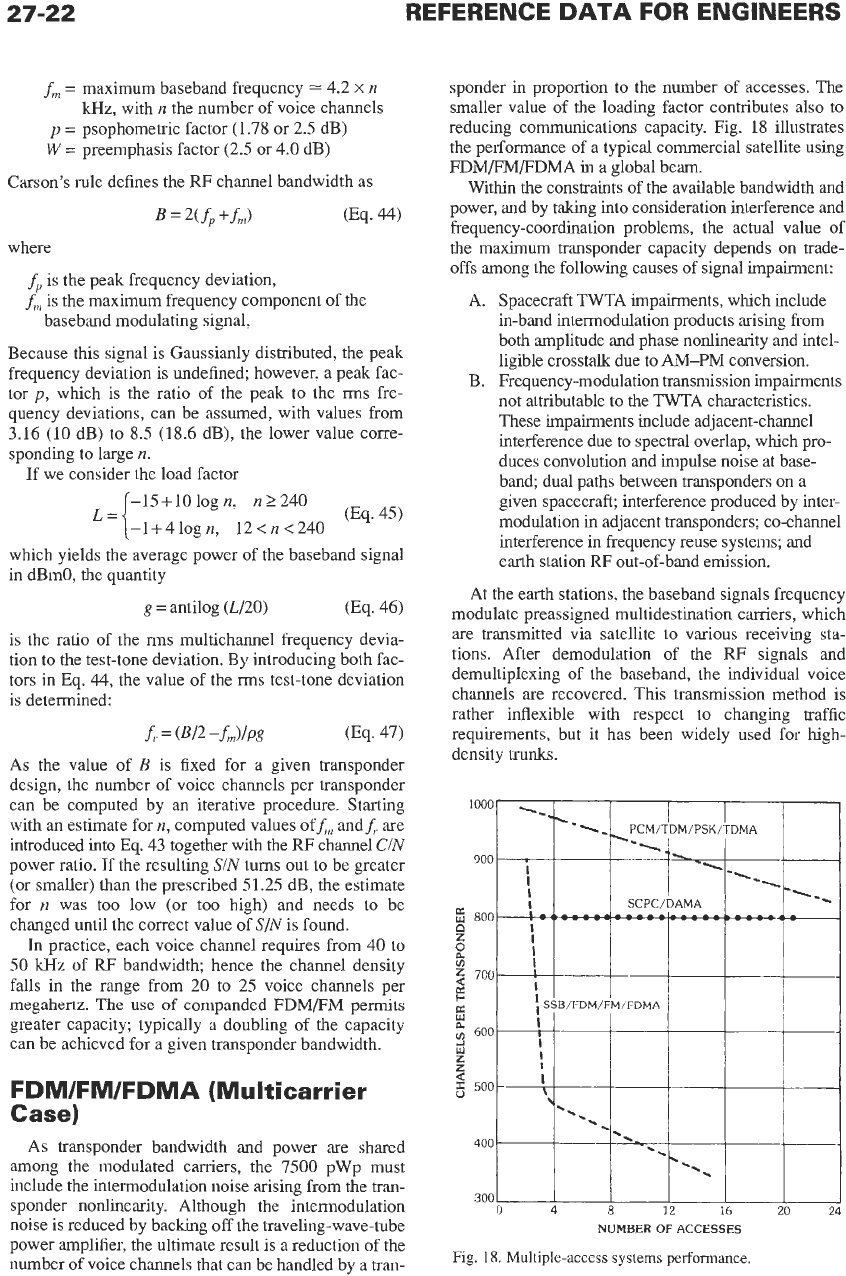
27-22
REFERENCE
DATA
FOR ENGINEERS
f,
=
maximum baseband frequency
=
4.2
X
n
kHz,
with
n
the number of voice channels
p
=
psophometric factor (1.78 or 2.5 dB)
W
=
preemphasis factor
(2.5
or 4.0 dB)
Carson's rule defines the
RF
channel bandwidth as
B
=
2(f,
+f,)
(Eq. 44)
where
f,
1s
the peak frequency deviation,
f,
is
the maximum frequency component
of
the
baseband modulating signal,
Because this signal is Gaussianly distributed, the peak
frequency deviation is undefined; however, a peak fac-
tor
p,
which is the ratio of the peak to the rms fre-
quency deviations, can be assumed, with values from
3.16
(10 dB) to
8.5
(18.6 dB), the lower value corre-
sponding to large
n.
If we consider the load factor
-15+10
log
n,
-1+4 log
n,
IZ
2
240
12
<
IZ
<
240
L={
0%.
45)
which yields the average power of the baseband signal
in dBmO, the quantity
g
=
antilog (L/20)
(Eq. 46)
is the ratio of the rms multichannel frequency devia-
tion to the test-tone deviation, By introducing both fac-
tors in Eq.
44,
the value of the rms test-tone deviation
is determined:
f,
=
(Bl2
-f,)lPg
(Eq. 47)
As the value of
B
is fixed for a given transponder
design, the number of voice channels per transponder
can be computed by an iterative procedure. Starting
with an estimate for
n,
computed values off, and
f,
are
introduced into Eq.
43
together with the
RF
channel
CIN
power ratio. If the resulting
SIN
turns
out
to
be greater
(or smaller) than the prescribed 51.25 dB, the estimate
for
IZ
was too low (or too high) and needs
to
be
changed until the correct value of
SIN
is found.
In practice, each voice channel requires from 40
to
50
kHz of
RF
bandwidth; hence the channel density
falls in the range from 20
to
25
voice channels per
megahertz.
The
use
of
companded
FDM/FM
permits
greater capacity; typically a doubling of the capacity
can be achieved for a given transponder bandwidth.
FDM/FM/FDMA (Multicarrier
Case)
As
transponder bandwidth and power are shared
among the modulated carriers, the 7500 pWp must
include the intermodulation noise arising from the tran-
sponder nonlinearity. Although the intermodulation
noise is reduced by backing
off
the traveling-wave-tube
power amplifier, the ultimate result is a reduction
of
the
number of voice channels that can be handled by a tran-
sponder in proportion
to
the number of accesses. The
smaller value of the loading factor contributes also
to
reducing communications capacity. Fig. 18 illustrates
the performance of a typical commercial satellite using
FDM/FM/FDMA in a global beam.
Within the constraints of the available bandwidth and
power, and by taking into consideration interference and
frequency-coordination problems, the actual value of
the maximum transponder capacity depends
on
trade-
offs
among the following causes of signal impairment:
A. Spacecraft TWTA impairments, which include
in-band intermodulation products arising from
both amplitude and phase nonlinearity and intel-
ligible crosstalk due to AM-PM conversion.
B. Frequency-modulation transmission impairments
not attributable to the TWTA characteristics.
These impairments include adjacent-channel
interference due to spectral overlap, which pro-
duces convolution and impulse noise at base-
band; dual paths between transponders
on
a
given spacecraft, interference produced by inter-
modulation in adjacent transponders; co-channel
interference in frequency reuse systems; and
earth station
RF
out-of-band emission.
At the earth stations, the baseband signals frequency
modulate preassigned multidestination carriers, which
are transmitted via satellite
to
various receiving sta-
tions. After demodulation of the
RF
signals and
demultiplexing of the baseband, the individual voice
channels are recovered. This transmission method is
rather inflexible with respect
to
changing traffic
requirements, but it has been widely used for high-
density
trunks.
NUMBER
OF
ACCESSES
Fig.
18.
Multiple-access
systems
performance.
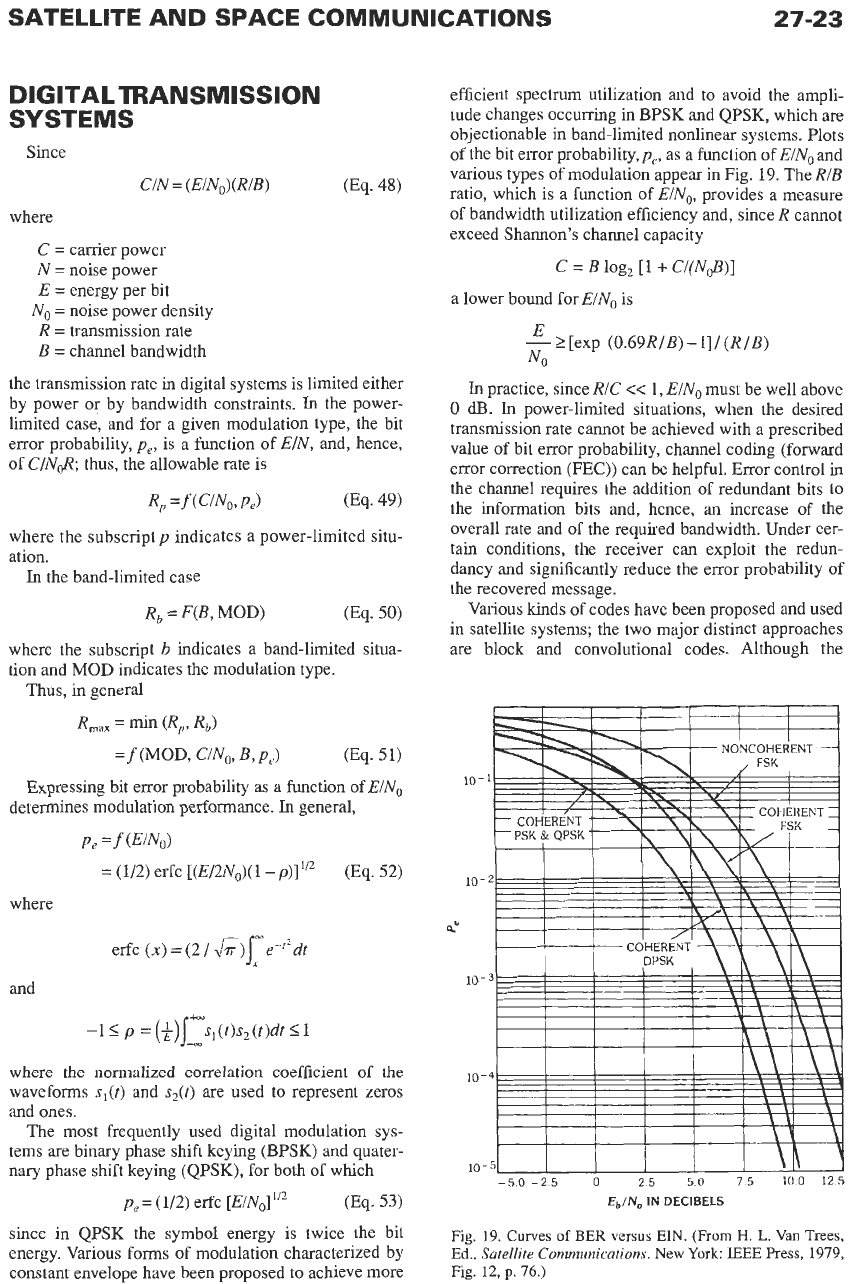
SATELLITE AND SPACE COMMUNICATIONS
27-23
DIGITAL TRANSMISSION
SYSTEMS
Since
CIN
=
(EINo)(RIB)
(Eq.
48)
where
C
=
carrier power
N
=
noise power
E
=
energy per bit
No
=
noise power density
R
=
transmission rate
B
=
channel bandwidth
the transmission rate in digital systems is limited either
by power or by bandwidth constraints.
In
the power-
limited case, and for a given modulation type, the bit
error probability,
pe,
is a function of
EIN,
and, hence,
of
CINd?;
thus, the allowable rate is
where the subscript
p
indicates a power-limited
situ-
ation.
In
the band-limited case
Rb
=
F(B,
MOD)
(Eq.
50)
where the subscript
b
indicates a band-limited situa-
tion and MOD indicates the modulation type.
Thus, in general
Rmax
=
min
(Rp, Rb)
=f
(MOD,
ClNo,
B,
P,)
(Eq.
5
1)
Expressing bit error probability as a function of
E/N0
determines modulation performance.
In
general,
Pe
=f
(EiN0)
=
(1/2)
erfc
[(E/2N0)(
1
-
p)]
liZ
(Eq.
52)
where
and
where the normalized correlation coefficient of the
waveforms
sl(t)
and
sz(t)
are used to represent zeros
and ones.
The most frequently used digital modulation sys-
tems are binary phase shift keying (BPSK) and quater-
nary
phase shift keying (QPSK), for both of which
since
in
QPSK the symbol energy is twice the bit
energy.
Various
forms of modulation characterized by
constant envelope have been proposed to achieve more
efficient spectrum utilization and to avoid the ampli-
tude changes occurring in BPSK and QPSK, which are
objectionable in band-limited nonlinear systems. Plots
of
the bit error probability,
pe,
as a function of
EiNo
and
various types of modulation appear in Fig.
19.
The
RIB
ratio, which is a function of
EINo,
provides a measure
of bandwidth utilization efficiency and, since
R
cannot
exceed Shannon’s channel capacity
C
=
B
log,
[l
+
CI(N&)]
a lower bound for
EIN,
is
E
-
t
[exp
(0.69R/B)-l]/(R/B)
NO
In
practice, since
RIC
<<
1,
EINo
must be well above
0
dB.
In
power-limited situations, when the desired
transmission rate cannot be achieved with a prescribed
value
of
bit error probability, channel coding (forward
error correction (FEC)) can be helpful. Error control
in
the channel requires the addition of redundant bits to
the information bits and, hence, an increase of the
overall rate and of the required bandwidth. Under cer-
tain conditions, the receiver can exploit the redun-
dancy and significantly reduce the error probability of
the recovered message.
Various kinds of codes have been proposed and used
in satellite systems; the two major distinct approaches
are block and convolutional codes. Although the
-50-25
0
25 50 75
100
125
EbIN,
IN
DECIBELS
Fig. 19. Curves
of
BER
versus EIN. (From
H.
L.
Van
Trees,
Ed.,
Satellite Communications.
New
York:
IEEE
Press, 1979,
Fig.
12,
p.
76.)
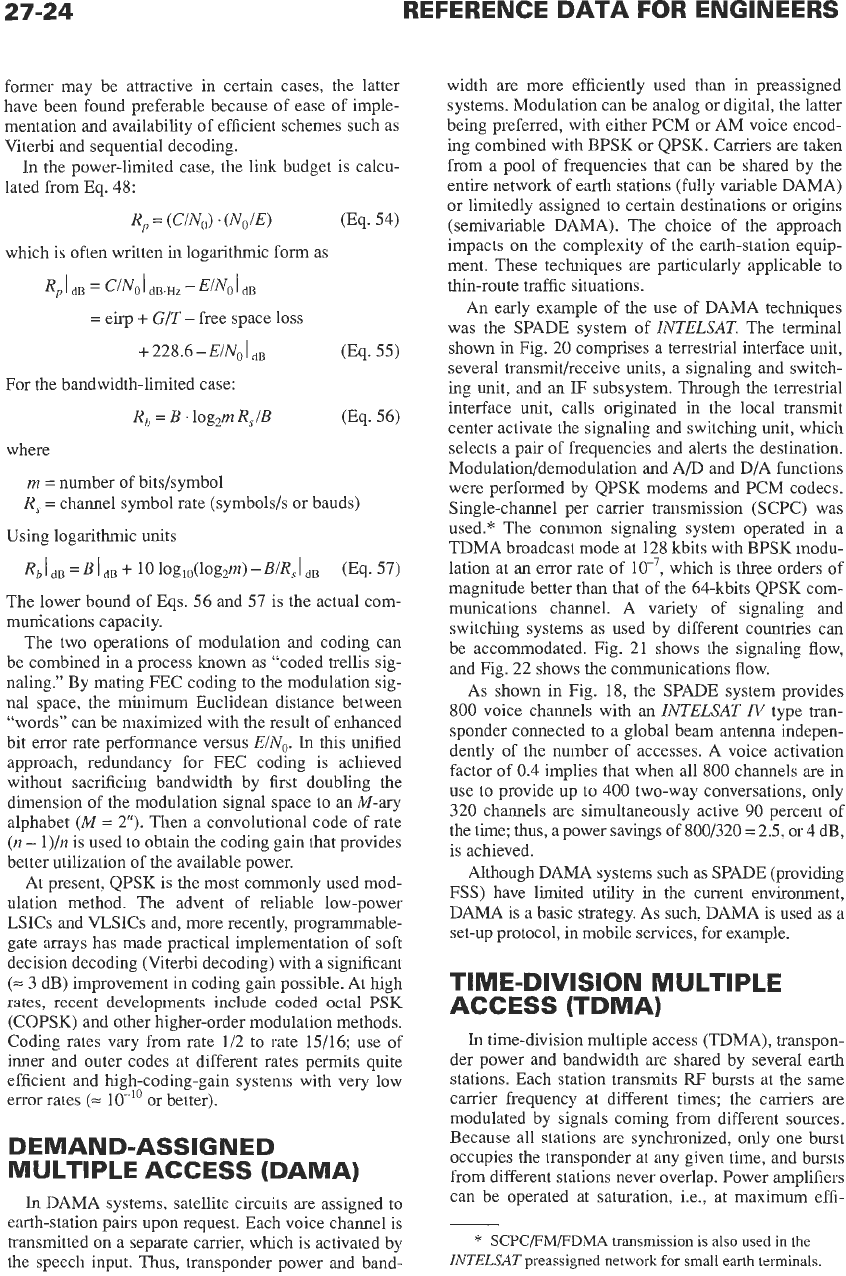
27-24
REFERENCE
DATA
FOR ENGINEERS
former may be attractive in certain cases, the latter
have been found preferable because of ease of imple-
mentation and availability of efficient schemes such
as
Viterbi and sequential decoding.
In the power-limited case, the link budget is calcu-
lated from Eq.
48:
Rp
=
(C/No) .(No/E)
(Eq. 54)
which is often written in logarithmic form as
Rp
I
dB
=
c/No
I
dB.&
-
E/No
I
dB
=
eirp
+
G/T
-
free space loss
+
228.6
-E/No
I
dB
R,
=
B
.
log2m
R,/B
(Eq.
55)
(Eq. 56)
For the bandwidth-limited case:
where
m
=
number of bits/symbol
R,
=
channel symbol rate (symbols/s or bauds)
Using logarithmic units
R,
I
dB
=
B
I
dB
f
10
lOg,0(lOg2m)
-BIR,
I
dB
(Eq.
57)
The lower bound of Eqs. 56 and
57
is the actual com-
munications capacity.
The two operations of modulation and coding can
be combined in
a
process known
as
“coded trellis sig-
naling.” By mating FEC coding to the modulation sig-
nal space, the minimum Euclidean distance between
“words” can be maximized with the result of enhanced
bit error rate performance versus
E/No.
In
this unified
approach, redundancy for FEC coding is achieved
without sacrificing bandwidth by first doubling the
dimension
of
the modulation signal space to an
M-ary
alphabet
(M
=
2”). Then a convolutional code of rate
(n
-
l)/n is used to obtain the coding gain that provides
better utilization of the available power.
At present, QPSK is the most commonly used mod-
ulation method. The advent of reliable low-power
LSICs and VLSICs and, more recently, programmable-
gate arrays has made practical implementation of soft
decision decoding (Viterbi decoding) with
a
significant
(=
3 dB) improvement in coding gain possible. At high
rates,
recent developments include coded octal
PSK
(COPSK) and other higher-order modulation methods.
Coding rates vary from rate 1/2 to rate 15/16; use of
inner and outer codes at different rates permits quite
efficient and high-coding-gain systems with very low
error rates
(=
lo-”
or better).
DEMAND-ASSIGNED
MULTIPLE ACCESS
(DAMA)
In
DAMA systems, satellite circuits are assigned to
earth-station pairs upon request. Each voice channel is
transmitted on a separate carrier, which is activated by
the speech input. Thus, transponder power and band-
width are more efficiently used than in preassigned
systems. Modulation can be analog or digital, the latter
being preferred, with either PCM or AM voice encod-
ing combined with BPSK or QPSK. Carriers are taken
from a pool of frequencies that can be shared by the
entire network of earth stations (fully variable DAMA)
or limitedly assigned to certain destinations or origins
(semivariable DAMA). The choice of the approach
impacts on the complexity of the earth-station equip-
ment. These techniques
are
particularly applicable to
thin-route traffic situations.
An early example of the use of DAMA techniques
was the SPADE system of
INTELSAT.
The terminal
shown in Fig. 20 comprises a terrestrial interface unit,
several transmit/receive units,
a
signaling and switch-
ing unit, and an
IF
subsystem. Through the terrestrial
interface unit, calls originated in the local transmit
center activate the signaling and switching unit, which
selects a pair of frequencies and alerts the destination.
Modulation/demodulation and A/D and D/A functions
were performed by QPSK modems and PCM codecs.
Single-channel per carrier transmission (SCPC) was
used.* The common signaling system operated
in
a
TDMA broadcast mode at 128 kbits with BPSK modu-
lation at an error rate
of
which is three orders of
magnitude better than that of the 64-kbits QPSK com-
munications channel. A variety of signaling and
switching systems
as
used by different countries can
be accommodated. Fig. 21 shows the signaling flow,
and Fig. 22 shows the communications flow.
As shown in Fig. 18, the SPADE system provides
800
voice channels with an
INTELSAT
IV
type tran-
sponder connected to
a
global beam antenna indepen-
dently of the number of accesses. A voice activation
factor of
0.4
implies that when all
800
channels are in
use
to
provide up to 400 two-way conversations, only
320 channels are simultaneously active
90 percent of
the time; thus, a power savings of 800/320
=
2.5, or
4
dB,
is achieved.
Although DAMA systems such as SPADE (providing
FSS) have limited utility
in
the current environment,
DAMA is a basic strategy. As such, DAMA is used as a
set-up protocol, in mobile services, for example.
TIM
E-DIVISION MULTIPLE
ACCESS
(TDMA)
In
time-division multiple access (TDMA), transpon-
der power and bandwidth are shared by several earth
stations. Each station transmits
RF
bursts at the same
carrier frequency at different times; the carriers are
modulated by signals coming from different sources.
Because all stations are synchronized, only one burst
occupies the transponder
at
any given time, and bursts
from different stations never overlap. Power amplifiers
can be operated at saturation, i.e., at maximum effi-
*
SCPC/FM/FDMA
transmission
is
also
used
in
the
INTELSAT
preassigned network for small earth terminals
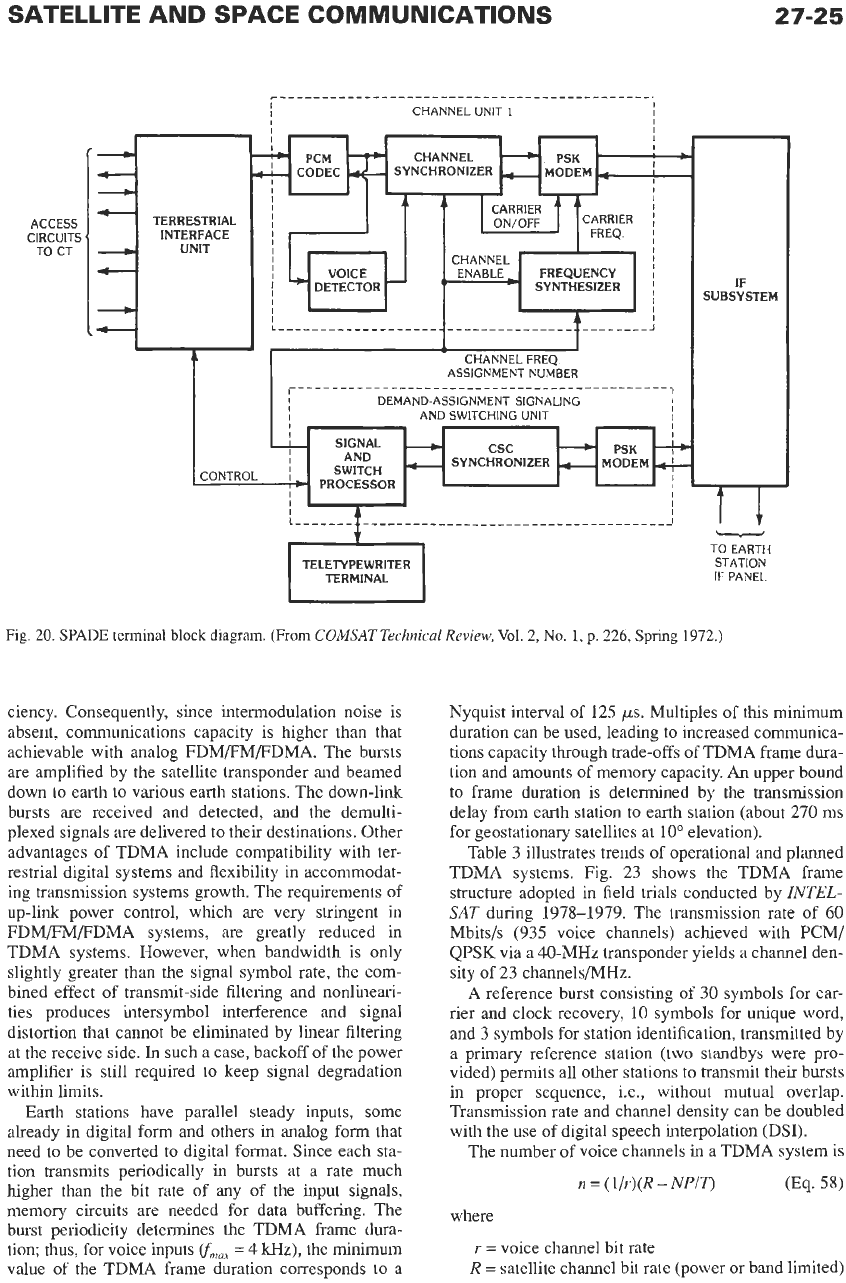
SATELLITE
AND
SPACE COMMUNICATIONS
ACCESS
CIRCUITS
'
TO CT
27-25
I
I I
I
I
I
I
I
CHANNEL UNIT
1
I
DEMAND-ASSIGNMENT SIGNALING
STATION
IF
PANEL
Fig.
20.
SPADE
terminal
block
diagram. (From
COMSAT Technical Review,
Vol.
2,
No.
1,
p.
226,
Spring
1972.)
ciency. Consequently, since intermodulation noise is
absent, communications capacity is higher than that
achievable with analog FDMEMPDMA. The bursts
are amplified by the satellite transponder and beamed
down to earth to various earth stations. The down-link
bursts
are
received and detected, and the demulti-
plexed signals
are
delivered
to
their destinations. Other
advantages of TDMA include compatibility with ter-
restrial digital systems and flexibility
in
accommodat-
ing transmission systems growth. The requirements of
up-link power control, which are very stringent in
FDMPMEDMA systems, are greatly reduced in
TDMA systems. However, when bandwidth is only
slightly greater than the signal symbol rate, the com-
bined effect of transmit-side filtering and nonlineari-
ties produces intersymbol interference and signal
distortion that cannot be eliminated by linear filtering
at the receive side.
In
such a case, backoff of the power
amplifier
is
still required to keep signal degradation
within limits.
Earth stations have parallel steady inputs, some
already in digital form and others in analog form that
need to be converted to digital format. Since each sta-
tion transmits periodically in bursts at a rate much
higher than the bit rate of any of the input signals,
memory circuits are needed for data buffering. The
burst periodicity determines the TDMA frame dura-
tion; thus, for voice inputs
fmm
=
4
Hz),
the minimum
value of the TDMA frame duration corresponds
to
a
Nyquist interval of 125
ps.
Multiples of this minimum
duration can be used, leading to increased communica-
tions capacity through trade-offs
of
TDMA frame dura-
tion and amounts of memory capacity.
An
upper bound
to
frame duration is determined by the transmission
delay from earth station
to
earth station (about 270 ms
for geostationary satellites at
10"
elevation).
Table 3 illustrates trends of operational and planned
TDMA systems. Fig. 23 shows the TDMA frame
structure adopted in field trials conducted by
INTEL-
SAT
during 1978-1979. The transmission rate of
60
Mbits/s (935 voice channels) achieved with PCM/
QPSK via a 40-MHz transponder yields a channel den-
sity of 23 channels/MHz.
A reference burst consisting
of
30 symbols for car-
rier and clock recovery, 10 symbols for unique word,
and 3 symbols for station identification, transmitted by
a primary reference station (two standbys were pro-
vided) permits all other stations to transmit their bursts
in proper sequence, i.e., without mutual overlap.
Transmission rate and channel density can be doubled
with the use of digital speech interpolation (DSI).
The number of voice channels
in
a TDMA system is
It
=
(l/r)(R
-
NPK)
(Eq.
58)
where
r
=
voice channel bit rate
R
=
satellite channel bit rate (power or band limited)
